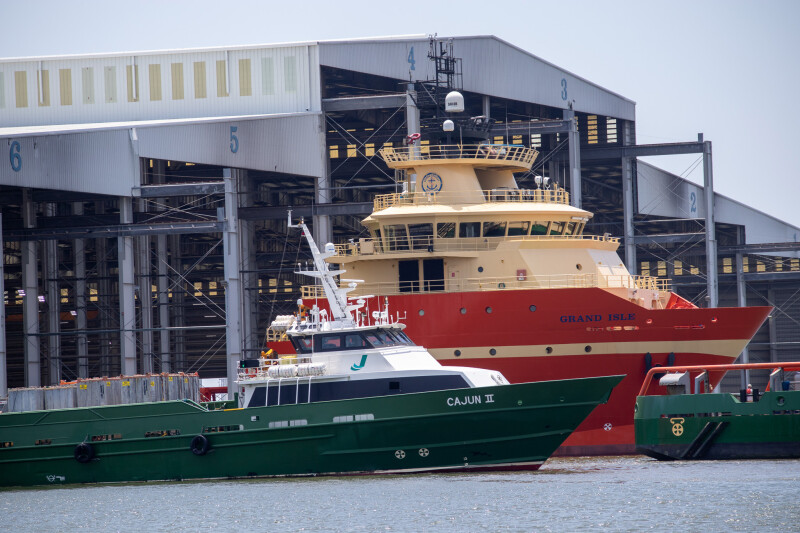Offshore wind is providing little competition to oil and gas production so far
President Joe Biden wants the U.S. offshore wind industry to be producing 30 gigawatts of electrical power by 2030 — enough, the administration says, to power 10 million homes. That would be the equivalent of about 16,920 bbls. of petroleum per hour or 384,000 bbls. of oil per day.
By comparison, the Energy Information Administration (EIA) says the U.S. consumes approximately 20 million bbls. of petroleum, including oil and natural gas, per day.
Indeed, according to 2023 EIA statistics, if every bit of the residential electricity in this country were produced by wind power, it would be less than enough to meet half of U.S. home energy needs. Nearly all of the crude oil that is produced in or imported into the U.S. is refined into petroleum products, such as gasoline, diesel fuel, heating oil, and jet fuel. Liquids produced from natural gas processing are also consumed as petroleum products, according to the EIA.
So far, there are no plans to import wind energy into the U.S., even if that were possible. Consequently, offshore wind will not unseat oil and gas production as the prime source of energy production in the U.S. anytime soon, certainly not by 2030. In fact, big oil is pulling back on some of its offshore wind involvement. According to Reuters, Shell pulled out of a South Korean floating offshore wind project in February to concentrate on more profitable ventures.
Last summer, Shell’s CEO Wael Sawan told the BBC, “The reality is the energy system of today continues to desperately need oil and gas,” he said. “I think what would be dangerous and irresponsible [would be] to actually cut out oil and gas production so that the cost of living — as we saw just last year — starts to shoot up again.”
BP, meanwhile, had aimed to reduce emissions by 35% to 40% by the end of the decade, but in March 2023 scaled back the declaration to a 20% to 30% reduction target. Both oil giants have stated the transition to renewable energy must be a more gradual process with oil and gas carrying the load for now.
LEASE SALES
The Bureau of Ocean Energy Management (BOEM) in January released final revisions to its bid adequacy procedures.
The updated rules are designed to ensure that U.S. taxpayers receive fair market value from Outer Continental Shelf (OCS) oil and gas lease sales. BOEM intends to begin using the revised procedures to evaluate lease sale bids received as part of the 2024-2029 National OCS Oil and Gas Leasing Program.
The revisions include the following:
- Update BOEM’s methodology for measuring the adequacy of bids for OCS oil and gas lease sales to enhance clarity and transparency.
- Discontinue the use of tract classification, which has had minimal impact on the procedural analysis of fair market value.
- Include other, minor changes to clarify and streamline processes.
BOEM published its proposed revisions in the Federal Register and received over 15,500 public comments. The final Gulf of Mexico Oil and Gas Lease Sale — 261 — not subject to the new revisions was held in late December 2023. The sale generated over $382 million in high bids for 311 tracts covering 1.7 million acres in federal waters of the Gulf of Mexico. A total of 26 companies participated in the lease sale, submitting 352 bids totaling about $442 million.
Under a ruling from the U.S. Court of Appeals for the Fifth Circuit in New Orleans, BOEM included lease blocks that were previously excluded due to potential impacts to the Rice’s whale population from oil and gas activities in the Gulf of Mexico.

Revenues received from offshore oil and gas leases (including high bids, rental payments, and royalty payments) are directed to the U.S. Treasury, certain Gulf Coast states (Texas, Louisiana, Mississippi, and Alabama) and local governments, the Land and Water Conservation Fund, and the Historic Preservation Fund.
Lease Sale 261 offered 13,482 unleased blocks on 72.7 million acres in the Gulf’s Western, Central and Eastern Planning Areas. The $382 million is a substantial increase over the $264 million in high bids for 313 tracts covering 1.6 million acres in federal waters of the Gulf in March 2023.
LEGAL COMPLICATIONS
As far as offshore oil and gas production is concerned, getting the energy from out there to in here is not only expensive but also subject to state, federal, and maritime law.
“Maritime law applies to vessels, maritime commerce, and maritime personnel. However, what a ‘vessel’ is and who a ‘seaman’ is in the offshore energy context is not readily apparent,” said Grady Hurley, a partner in and co-leader of the maritime litigation, arbitration, and dispute resolution team…
Read More: Offshore wind is providing little competition to oil and gas production so far

